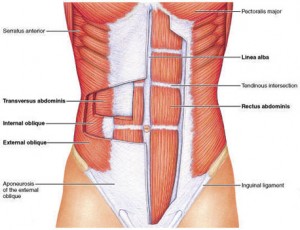 Someone recently sent me the above paper that was published a few years ago, The Myth Of Core Stability, by Professor Eyal Lederman.
Someone recently sent me the above paper that was published a few years ago, The Myth Of Core Stability, by Professor Eyal Lederman.
I am always a fan of the counter-intuitive approach and after reading it I can say that everything posited in the paper is accurate but I can also say that the findings are not particularly useful to me.
I am reprinting the conclusions of the paper below though the whole piece is worth a read:
Weak trunk muscles, weak abdominals and imbalances between trunk muscles groups are not pathological, just a normal variation. The division of the trunk into core and global muscle system is a reductionist fantasy, which serves only to promote CS. Weak or dysfunctional abdominal muscles will not lead to back pain.Tensing the trunk muscles is unlikely to provide any protection against back pain orreduce the recurrence of back pain.Core stability exercises are no more effective than, and will not prevent injury more than, any other forms of exercise. Core stability exercises are no better than other forms of exercise in reducing chronic lower back pain. Any therapeutic influence is related to the exercise effects rather than CS issues.There may be potential danger of damaging the spine with continuous tensing of the trunk muscles during daily and sports activities. Patients who have been trained to use complex abdominal hollowing and bracing maneuvers should be discouraged from using them.
The bottom line from my perspective is that it is better to be strong than weak, simple as that.
Also though what he says in this paper, The Myth of Core Stability is accurate technically, I have seen so many people get relief from back pain and lead more productive lives by developing better core strength. I only have my own experience to go by but I have worked with a lot of bodies.
The second and most important part of developing core stability for pack pain relief is that it has to be coupled with changing one’s posture and movement patterns.
I would like to see a study that examines this type of two-part solution.
Build both core stability and change the way one walks and stands and I think his findings would be very different.
Everything written in the paper contradicts the piece of my approach that advocates building specific muscle tone to help people with lower back pain and chronic lower back pain.
Again I have no hard data to go on but I have seen first-hand the efficacy of building core strength as a means of creating a healthier body that can age more gracefully due to better muscle tone and balance. He argues that you can’t build muscles in isolation, and developing them with a particular exercise doesn’t help those muscles when in different positions.
Lederman has very little interest in the very big interest that many pain professionals have in the transverse abdominis muscle of the abdomen.
He mocks exactly what I believe which is that even though you can’t isolate a muscle technically, you can do exercises that ask more of a particular muscle than others.
It is my take that the brain recruits an available muscle and the available muscle isn’t always the most effective so trying to train different muscles for a given function is useful.
I teach that in the case of many actions requiring abdominal engagement the brain often recruits the rectus abdominis when the transverse abdominis should be more in the game.
So I try to “isolate” the transverse even though I also teach that isolation isn’t exactly happening but you can try to feel a distinction between which muscles are working.
We agree about one thing in that I don’t want people to be walking around, or even exercising, and engaging muscles.
We should live naturally—when teaching someone who is very weak to walk I might tell them to engage their muscles to feel them but in the long run they want to build tone through specific exercise that is then supplied unconsciously during movement.
When I do a demonstration of a pose in a yoga class I am just doing the pose, not making a muscle to make it happen. But if someone doesn’t have the requisite muscle tone that can’t happen successfully.
The main thing he doesn’t address, and admittedly is not the point of the paper, but which is so important to what I do is the two fold approach I mentioned of building muscle and changing movement patterns at the same time.
The Myth Of Core Stability is an interesting read but doesn’t really help me to better understand how to help people with pain issues.
From my perspective posture and walking patterns are the most common reasons that people with lower back pain and chronic lower back pain fail to alleviate their problems.
He makes a distinction between two types of back injury—load related and accident related. But I have found in both of these types of injury the two fold approach of building core tone and changing movement patterns to be highly effective.
***
